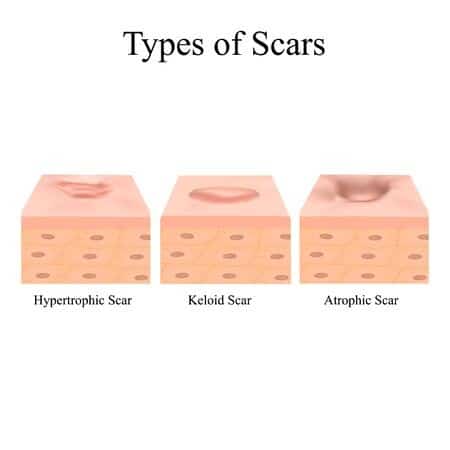Have questions about Acne scars and want to understand them better? Well, we’ve got you covered! They’re under our beauty microscope this week, so scroll down to read what exactly acne scars are and what are some possible ways you could reduce, or treat them:

What Are Acne Scars?
Acne scars appear after your acne starts to fade. They are the product of skin pores swelling and causing a break in the follicle wall. Lesions that are not too deep are easier to heal, but when the abrasion is deep, it’s harder for the skin to form new collagen fibers that smoothly repair the skin. As we age, we lose collagen and the acne scars become more noticeable but depending on the type of acne scar you have, it can be treated.

Types Of Acne Scars
Hypertrophic Or Keloid Scarring
This is the most common type of scarring to develop due to acne. They appear as raised lesions of scar tissue and are a consequence of the excessive growth of fibrous tissue in the area where the acne lesion was formed. Keloid scars are larger than the acne lesion that caused them, while Hypertrophic scars are of the same size. The treatment for such scars involves levelling the skin surface and making it flat, and then reducing skin discolouration in the flat scar. To level the skin, steroid injections, dermabrasion, laser therapy or chemical peels can be used. Dermabrasion, laser and chemical peels also help with discolouration, alongside microneedling.
Atrophic Or Depressed Scarring
Atrophic scars develop when there is a loss of tissue. It has two forms – the ‘icepick‘ scars which are small, but obvious holes in the skin, and the ‘boxcar‘ scars that appear as indents in the skin. The former usually appear where the skin is thinner, such as the forehead or the cheeks. The latter affects thicker skin, such as the jaw. Similar to keloid and hypertrophic scarring, treatment for atrophic scarring also requires the skin surface to first be made flat, and then the skin discolouration to be treated.

Treatment/Removal For Acne Scars
- Dermabrasion: This uses a high speed brush or some other special tool to remove the top layers of the skin by friction. When they are removed, the skin becomes flatter, with reduced discolouration. As the skin heals, a new, smoother layer replaces the abraded skin. This can take 10 days to 3 weeks to heal.
- Chemical Peels: This treatment is for shallow acne scars as it can lead to discolouration and texture changes in deeper scars. It removes he outer layers of skin using high concentrations of glycolic or salicylic acid.
- Laser Therapy: Laser therapies work in two ways. Ablative laser therapy uses high-energy light to remove the outer layers of the skin while encouraging collagen production in the lower layers of the skin. Non-ablative laser therapy uses heat to encourage collagen production in the skin, without damaging the outer layer. The removal of the outer layers and/or the production of new collagen results in a reduction in scar depth, and the high-energy light used during the laser reduced discolouration. However, there are multiple laser therapies available for acne scarring and your dermatologist will best be able to guide you on which one is suitable for your skin type.
- Microneedling: This involves inserting into the skin surrounding the scar to stimulate the body to make new collagen. As the new collagen forms, it reduces the scar’s depth and allows old skin cells to shed, including skin cells that have been discoloured by excess pigment.
- Punch Excision: This is used for deeper, or atrophic scarring, especially icepick scars. A needle is used to cut out the scar tissue. The hole left by the incision can be repaired with stitches or a skin graft to form a new, flat scar.
- Subcision: This method loosens the area around the indented scar and creates a new wound that can heal properly and match your normal layer of skin. This method is mainly used for atrophic scars and ‘boxcar’ scars in particular.
- Dermal Fillers: A substance such as collagen, hyaluronic acid, or fat is injected into the skin to physically push the skin above it upwards. You will have to repeat filler injections every few months, depending on the type of product used.







What do you think?
You must be logged in to post a comment.